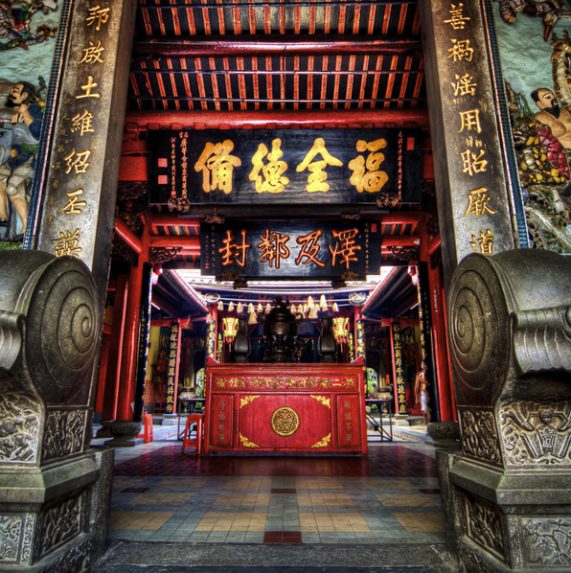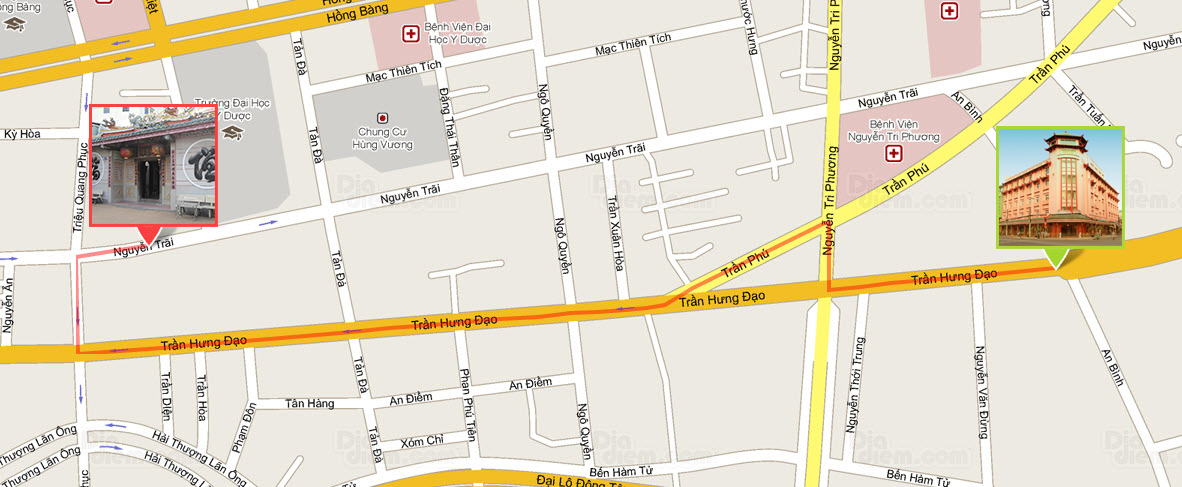Hotline : (+84)938.353.766
Email : sales@dongkhanhhotel.com


In the temple, the main worshiped deity is Quan Cong (aka Quan Vu , 162 – 219 ), a figure from the Three Kingdoms period . To the Chinese , he was a person of integrity and integrity . Therefore, the temple is named Quan De Temple . And because this is also a meeting place for Chaozhou people , it is also known as Nghia An Hoi Quan (Nghia An is the name of a land in Guangdong in China , where most of the Chaozhou people live). However, this temple is often called Ong pagoda after many people’s habits .
According to scholar Vuong Hong Sen , the Quan De Temple by Chinese origin Chaozhou built before the 19th century , but in 1819 – 1820 new construction solidly until today .
Therefore, around 1820 , when writing about the ancient Saigon market ( today’s Cholon ), Trinh Hoai Duc in Gia Dinh citadel (Citadel) will mention this temple: At the North end of the big street, there is a temple. Quan Thanh and the three guilds of Fuzhou , Guangdong and Chaozhou split on the left sides of the right … Whenever meeting beautiful weather on the moon night, the days of the plateau, the squirrels hung the lights, put the judgment, clever competition .. .
In addition, in Gia Dinh phu of an anonymous author (composed before the start of Le Van Khoi in 1833 ), the temple was also mentioned: Dazzling brilliance! Ong Quan De Pagoda, lofty loyalty even thousands of years …
In addition, there is a large stele in the temple stating that Do Thi (wife of Ta Quan Le Van Duyet ) offered two hundred mandarins in 1819 , and a bronze censer made in the fifth Dao Quang year. ( 1825 ) .
Since its permanent construction, the temple has been restored many times in 1866 , 1901 , 1969 , 1984 and most recently in 2010
As most of the temples of Chinese , Quan De Temple (Nghia An Hoi Quan) has shaped the overall architecture Exporters (囗) or alphabet (国) closed with glass blocks from perpendicular. In general, the architecture and decoration of the temple clearly show the Chaozhou style through design, through colors (red is the dominant color). All expressed the artistic values of calligraphy , stone carving, wood carving, porcelain puzzle pieces, … in the second half of the 19th century – early 20th century . Comb from outside to inside:
The temple roof has 3 levels: middle high, lower sides. On the roof is attached with a figurative figurine with a dragon- shaped dragon flower.
The temple yard is quite large, nearly 2,000 m² , accounting for more than half of the campus area. The rest consists of electricity money, the provincial court, the main hall and the meeting hall office along both sides of the shrines. From two large gates to the temple door, there are five pairs of large and small unicorns of stone placed symmetrically on each other. The most beautiful pair of “unicorn function” (unicorn pearl) flanking both sides of the door. Above, in front of the sign “Nghia An Assembly hall” hung a picture made in 1903 , embossing the scene “Lu Quoc phong phong”. On the wall of the front of the temple door, two Chinese characters are carved and six different bamboo branches .
From outside the yard to enter is the electricity. In the middle of the electricity bill, there was a incense burner, placed on a copper censer made in the fifth year of the Taoist year ( 1825 ). To the left of the electricity is the high pedestal worshiping Phuc Duc himself (most Chinese think this deity is Mr. De or the Earth god ). On the right is a statue of the General Ma Dau (the keeper of Xich Tho horse to Quan Cong) standing by Xich Tho horse (red painted wood over 2 m high). In addition, there is also a 39 cm high bell , 46 cm diameter, the two sides cast two unicorn heads , delicate lines, in the front there is the words “Emperor Quan”.
Thien Thien yard (Heaven well) in the middle of the temple is spacious and spacious with bonsai pots. Along the corridors on either side of the yard are steles dating from the temple restoration and the names of its contributors. According to Vuong Hong Sen, among the stele’s benefactors, there was a large stele inscription stating that Mrs. Do Thi, wife of Ta Quan Le Van Duyet, offered two hundred mandarins at that time (in 1819 ) and one stone stele clearly stated. What are the seven prefectures, all of which are fairy steles, heavily related to the history of Saigon ?
In the main hall is solemnly designed with statues of worship, high wooden pillars hanging from opposite sentences, along with the lam lam, diaphragm and exquisite carvings. In the middle of the palace, there is a place of worshiping Quan Thanh Imperial Emperor (Quan Vu) decorated with dimples and picturesque paintings. Statue made of colored plaster , 3 m high , wearing a blue brocade, sitting on the throne, placed in the examination to touch the edges of many parts of cranes, cranes, mai-birds, peonies, hemorrhoids, Bat Tienfighting with sea monsters … The image of Guan Gong shown here carries the details that have become conventional: the face is red, the beard is five-pointed to the chest, the posture of stroking the beard, the crown wearing a crown, he wore inner armor and a green vest outside (to indicate that he was a martial arts writer.) Standing at the two sides in front of the altar are the statues of Quan Binh and Chau Xuong nearly 2 m high .
Because Quan De was the main deity worshiped, most of the more than 50 galleries, the beautiful Chinese kangaroo sentences all praised him as: “The Ancient Wall of the Legacy” (Shining Stars Forever), “Thien the oldest human “(The ancients now only one),” The central means dangerous danger to the god of greed “(Qi means loyalty, high Germany comparable sky and earth), etc. … In addition, there are also an essay “Dao Quang thuc nien nien” ( 1827 ), recounting the merit of Quan De carved on beautiful gilded wood .
The two parties on the right have worshiping Thien Hau (Nguyen Thien Mau ) and Tai Bach ( Quan Tai ). The wooden statue of Thien Hau, 60 cm high, was seated on an armchair. According to the servants, there were two maids and two Thien Ly longan and Thuan phong ty. The God of Fortune is represented by a wooden statue, 60 cm high, also sitting on a chair touching the dragon’s head , the two sides have Chieu Tai pupils standing. The arrangement in these two compartments is similar to that of a phoenix that touches a phoenix and examines many scenes, such as: honor of the ancestors, chess, rowing, netting, shepherds riding buffalo, mai-bird, bamboo-bird, …
Close to the corner of the wall, there are two sets of symmetrical empty bells. The left bell is made of cast iron, cast in Buddha Tran ( Guangdong , China ) in the year of the Dog ( 1850 ?). The remaining bell is made of alloy, embossed with the words “Gia Dinh province, Minh Huong commune, Tan Truong Chau, Nghia An meeting hall …” (bells offered by Tan Truong Chau, presumably cast in the middle of the world 19th century ).
Every year, Quan De worship ceremony is held on June 24 ( lunar calendar ) and full moon in January (the largest). In addition, there are also worship ceremonies for Ba Thien Hau, Phuc Duc, etc.
